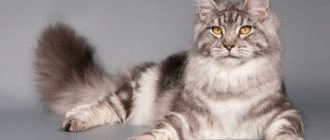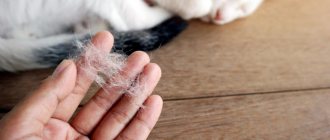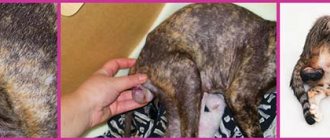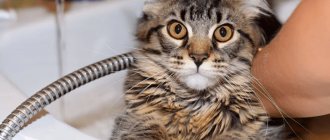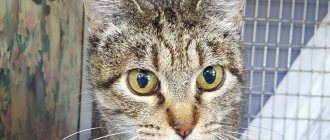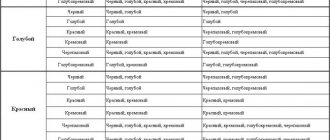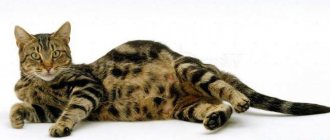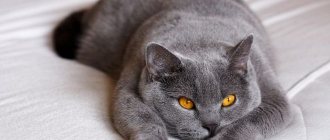Pregnancy in Maine Coons is longer than in other cat breeds. Therefore, kittens appear on average 7 - 10 days later than usual. How do the first signs of pregnancy appear and when should you expect babies? How to help the expectant mother and what complications may there be? What should a first aid kit consist of and what should be the place for childbirth? As well as advice on caring for a woman in labor.
First signs
The first signs of pregnancy appear approximately 3 weeks after the start of the last estrus. These include:
- Swelling of the cat's nipples (they become bright pink).
- Slight weight gain.
- No heat. The cat calms down and no longer asks for the cat.
- Changes in taste preferences (for example, the expectant mother begins to show interest in food to which she was previously indifferent, and vice versa).
There are no tests for feline pregnancy, but an interesting situation can be detected through ultrasound.
Home / Information – Info / Pregnancy and childbirth
Pregnancy.
From the first days of pregnancy, the cat is more sleepy than usual. She often has an increased appetite. It is very advisable to give her daily vitamins with a high calcium content (currently there are wonderful Brevers East vitamins for kittens and Stress Tabs with a high calcium content). In all other respects, the cat behaves as usual. Some of them experience toxicosis between the 3rd and 4th weeks of pregnancy, which is expressed in one or two times of vomiting and a short-term, slightly depressed state. On the 21st-28th day of pregnancy, the cat’s nipples usually swell. And after another week, the belly begins to grow. Don’t feel it, you won’t be able to tell how many kittens are there (this can be done by x-raying the cat, or using an ultrasound scan). But you can harm the kittens and, thereby, the mother without noticing. Explain to your young children that you should not pick up a pregnant cat (for the same reason - do no harm). Just feed the expectant mother plenty, provide her with a well-ventilated area and play with her as usual, but without picking her up. If, however, there is a need to take a pregnant cat, then take her under the chest and at the same time, supporting her under the butt.
On the 35-50th day of pregnancy, prepare a “nest” for childbirth and the future cat family. To do this, you can find a cardboard TV box with a size of approximately 90*90 cm and a height of 50 centimeters or more. Cut out one wall of the box (as in the picture). This wall should be the height of the cat’s chest, so that when jumping into the box, she can see where she is jumping and does not step on tiny kittens. On the other hand, the height should be sufficient so that three-week-old kittens, already wanting to get out of the nest, but still able to get lost in the apartment, would not be able to do this. That is, so that the height of the wall would be an obstacle...
Once you have prepared the box, put some old but clean newspapers in it. Let your cat take an interest in the box and begin to explore it. Start preparing a first aid kit for childbirth. Just in case. Prepare: a) scissors with which you will cut the umbilical cords (if necessary). b) disinfectant (alcohol or vodka). You will need it in case you have to intervene to disinfect your hands and scissors. c) traumeel (this is a homeopathic liquid that can be bought at a regular human pharmacy; just pay attention that traumeel is for injection, then it does not contain any added alcohol, which your mother in labor has absolutely no need for). By the way, the attitude of veterinarians and cat lovers to the use of traumeel during childbirth is different. I heard both positive reviews (75-80 percent of them) and indifferent ones (that’s everyone else). But I haven't heard any negative reviews. I have a positive attitude towards infusion of small doses of Traumeel into the mouth during childbirth. d) pipettes (1-2 pcs.), which are needed if you use traumeel. e) old but clean diapers (for rubbing babies, if necessary). e) a small enema (to suck out fluid from their mouth if they suddenly choke on amniotic fluid). g) disposable diapers (you can buy them at a regular pharmacy) so that your mother in labor lies in a dry and clean nest. h) for long-haired or semi-long-haired cats, prepare two old socks to put on the mother's hind legs during labor. Instead of wearing socks, you can cut your pants so that the wool does not get stained with blood. i) Telephone numbers of veterinarians, a preliminary agreement with them to come to you in the most urgent case. j) CONFIDENCE that both YOU and your wonderful cat are great, YOU can handle it! And everything will be fine!
Childbirth. A cat's pregnancy lasts an average of 66 days, starting from the first moment of mating. (That is, 65 days must be added to the first day of mating). Variations from 63 to 69 days are possible. The duration of pregnancy depends on the cat breed, climate (weather conditions), general condition and age of the cat and some other, less significant reasons.
3-5 days before birth there may be a slight mucous discharge. The day before giving birth, the cat may feel restless and look for a place to give birth, forgetting about the “nest”. She can climb into closets, under the sofa or into other secluded places in the apartment, dig through things, creating a new nest, hidden from everyone.
Another sign that labor is very close is a drooping tummy. About a day before giving birth, the sides of the pussy fall off, and when looking at it from above, it may even seem that the pregnancy has evaporated. Take a closer look and you will realize that the kittens are already in the lower abdomen. Everything is like people.
And then THAT very day comes. Your cat begins to run into its litter box especially often and does not eat anything. Remember that human women in labor in maternity hospitals are given enemas before giving birth. For cats, nature itself provided such a cleansing procedure (don’t even think about giving your cat an enema!!!). Then the cat’s water breaks (sometimes you may not notice this moment, but mistake it for frequent or increased urination).
From this moment until the first contractions there are from a few minutes to a couple of hours. Often the cat begins to purr very loudly in time with the beginning contractions. Approach the “nest” that you prepared in advance, calling the kitty to follow you. Most likely, she herself will follow you. Sit near the box and show the pussy where it should jump. Sit next to her and stroke her head and tummy. As soon as you feel another contraction, take 5 drops of traumeel into a pipette and pour it into the corner of the mother’s mouth. (How much space does 5 drops take up in a pipette? You must measure it in advance and make some kind of mark on the pipette). Next, set a watch in front of you and repeat the procedure with traumeel every 15 minutes. According to many veterinarians, traumeel promotes the elasticity of all muscles involved in labor. And, even if this is not the case, your mother in labor will still be happy to take 5 drops of slightly salty liquid. However, I am not a veterinarian. Only from my own experience and the experience of many of my colleagues I know that there will be no harm. (Just remember that the traumeel must be for injection or for special veterinary use).
So, you should have scissors calcined or disinfected with alcohol (vodka), a small enema, clean gauze wipes and old, cleanly washed sheets at the ready, at hand. On the 2nd - 3rd strong contraction, a kitten in a bag should appear in the cat's perineum. And for the next fight he must come out all. Don't fuss or get nervous. Try to wait until the baby's place (placenta) slips out too. Then, if the pussy doesn’t know WHAT to do with all this, carefully remove the film of the bag from the kitten’s face (so that it doesn’t choke or suffocate) and place the kitten’s face right under the kitty’s nose. Try to get her to start licking it herself. If the first-time mother does not yet understand what is required of her, then take the initiative into your own hands. Namely, cut off the umbilical cord with scissors at a distance of 6-8 cm from the kitten’s tummy (You can let the cat eat the baby seat, or you can immediately throw it in the toilet - it depends on your personal views. But more on that later). Then start rubbing the kitten with an old sheet. Dry. It is important that the kitten immediately shows signs of life: squealing, breathing, crawling somewhere in search of its mother’s breast, etc.
If this does not happen, then place the kitten on your palm with its hind legs to your wrist, head to your fingertips. And shake your head down quite sharply, fixing the head. This procedure can be done 3-5 times. As a rule, a slightly choked kitten after such shakes takes a sharp breath, clears its throat and begins to breathe and squeak normally.
If shaking does not help, then you must either suck out the liquid from the kitten’s lungs with a small enema, or perform artificial respiration, or use a contrast shower. However, all these actions require caution and, before carrying them out, you must carefully study special sections of the literature (for example, “Home Veterinary Directory”, authors: Delbert D. Carlson, James M. Giffin, L.D. Carlson in the section “Pregnancy and Childbirth” » paragraph “Stimulation of breathing of kittens” or on the website www.supercats.ru in the section of the same name, paragraph “first aid during childbirth”).
Next, vigorously rub the kitten. Try to expose the kitten to mommy's nose from time to time. So that she still understands WHAT she needs to do. All of the above procedures must be completed in no more than 5-7 minutes. (Remember that we give traumeel every 15 minutes). If the cat is going to rest before the next contractions, then place the kitten (even if still wet) on her nipple. A kitten that suckles immediately and well is usually a healthy kitten. In addition, sucking evokes the maternal instinct in the cat and the flow of milk, and also stimulates subsequent labor.
If the cat is about to give birth further, then put the kitten a little to the side so that the woman in labor does not accidentally crush it during contractions. The place where you place the kitten should be dry, soft and warm (28-30 degrees C). Kittens are born one after another every 20 minutes - 1 hour. If there are a lot of kittens (five or more), then the gap between each subsequent kitten may increase due to the fatigue of the woman in labor. Sometimes the last kitten is born a day after the previous one.
As a rule, after the birth of the last kitten, the cat calms down. And, even if it seems to you that she has one more kitten left in her belly, you are most likely mistaken: this is a tense, non-contracting uterus.
During childbirth, you must be collected, not panic, but cleanly and clearly help the mother and her children. Make sure that the birth of EACH kitten is accompanied by the birth of a child's place. Make sure that the kitten does not hang in the cat's crotch for more than a couple of minutes. Make sure that the kittens immediately show signs of life and are kept warm. Make sure everything around is clean, dry and comfortable.
Throw away any wet diapers, provide clean, dry bedding for kitty and her family, cover the top half of the box lid, and place a tray and bowl of fresh water next to the box. ALL! The cat is resting, the kittens are suckling. All you have to do is wash and put everything away. And let mommy rest and enjoy her motherhood.
The first days after childbirth. In the first days after birth, carefully observe the mother's vaginal discharge. If this discharge is insignificant, not scarlet, but rather reddish-brownish in color, and is not accompanied by an unpleasant odor, then everything is in order (such discharge can last for 7-10 days). All that remains is to monitor the cleanliness and warmth in the “nest”, ensure that there is always fresh water and feed the mother in triple or quadruple amounts. It would be very nice for a veterinarian to check the young mother: he felt the uterus, and looked at the discharge and the color of the milk and nipple. It's calmer this way. But, unfortunately, this is not always possible. See for yourself.
Ambulance during childbirth.
Or when you urgently need to call a veterinarian.
Always remember that in case of ANY doubt, it is better to be safe than to miss a complicated moment of childbirth. And yet, we will note several points in which urgent veterinary help is needed: The cat has strong contractions, but she cannot give birth for 1.5-2 hours. Bleeding (bright scarlet blood) for 10-15 minutes. A sudden rise in temperature (feel the tips of your ears) above 40 degrees or, conversely, a drop to 37 degrees (the temperature is measured with a regular thermometer). The kitten is stuck in the vagina and “hangs” for more than 10 minutes.
YOU and your wonderful cat - well done, YOU can do it! And everything will be fine!
The article was prepared by Sofia Petrovna Krasnoselskaya, owner of the elite cattery “Sweet Way”, WCF expert of the international category for all cat breeds
https://novcats.narod.ru/priobretenie.htm
Progression by week
Veterinarians distinguish the following stages of pregnancy by week:
- 3 weeks after mating, the first signs appear.
- At 3–4 weeks, the cat develops toxicosis (due to hormonal changes). In this case, drowsiness occurs and appetite worsens.
- In the fifth week, the expectant mother noticeably gains weight. The cat's appetite improves and its belly becomes rounder. The pet becomes calmer and more affectionate.
- At 6 - 8 weeks, kittens begin to move (this can be noticed when observing the pet). Maine-kunsha becomes anxious and tries to find a secluded place to give birth.
- The ninth and part of the tenth week is the last period of gestation. The pet loses its appetite and begins to actively lick its belly and vulva.
During the period of contractions, the cat rushes about in search of a suitable place and meows loudly, attracting the owner’s attention and demanding help and care from him. This period lasts about a day, after which labor begins.
When are we expecting babies and how many will there be?
A pregnant cat lasts an average of 9 - 10 weeks (or 70 - 72 days).
Moreover, the duration of gestation greatly depends on the number of kittens in the litter.
The more there are, the sooner they will be born (in order to reduce the load on the body, the cat gives birth faster).
Babies born before the 62nd day have poor health and therefore require special care (otherwise they risk not surviving). In Maine Coons, the number of kittens in a litter is approximately 4 - 6, but there are cases where cats of this breed carried 10 kittens.
It is not recommended to feel the belly of a expectant mother in order to determine the number of fetuses in the womb, since it is possible to damage the vital organs of the cat - the mother or the offspring she is carrying.
Sexual maturity of Maine Coon cats
Sexual maturity in these cats occurs at 7-9 months. Unlike the female, the male is less reserved and more playful and active. Maine Cooncat cats will periodically go into heat without being spayed. In cats, the process of puberty boils down to constant readiness to mate.
Optimal age for mating
During the first heat, it is recommended to refrain from mating. A year to a year and a half is the ideal time for a Maine coon to breed for the first time. At this age, she is already ready to bear healthy offspring. How many Maine Coons carry kittens may also depend on the age at which the breeding takes place.
Important! early mating provokes a problematic pregnancy, but keeping an animal without mating until the age of two or three years is completely impractical and dangerous for the health of the animal.
Signs and duration of estrus
In order for the estrus period to pass painlessly both for the cat itself and for its owner, you need to know about the features of this process. By the first heat, the female Maine Coon should already have gained approximately 80% of her body weight. If your cat is growing quickly and gaining weight well, then her first heat will most likely begin quite early. The first signs of a cat's heat: - the cat becomes especially affectionate and demands more attention to itself, - inviting, atypical meowing for its voice. It can be loud, and it can be quiet. Let's not forget about individuality: - a cat can roll on the floor, calling for a cat, - the gait on the floor crouches - when we stroke the back, it begins to bend, and the tail rises.
How long does a Maine Coon's heat last? Basically, the duration of estrus is 7 - 11 days. Sometimes cats can experience nymphomania, when the estrus in Maine Coons lasts for a month or more. Mating or sterilization may help with this.
Help for the expectant mother
The appropriate age for the first pregnancy is 8 - 10 months.
It is during this period (not earlier) that the pet is physically and hormonally ready to become a mother.
The correct course of pregnancy and appropriate care will help not only to avoid complications in the process of bearing kittens and subsequent births, but also to maintain the health of the cat.
It is advisable to start taking care of the animal even before mating with a cat. Therefore, it is important for the owner to know the basics of proper pet care (food, rest, help during toxicosis).
Postpartum care
After the birth is over, it is necessary to examine the cat and feel her stomach to check that there are no kittens inside. If the kittens can be felt inside, you should wait, perhaps the cat will give birth to them a little later. If this does not happen within 24 hours, you should consult a specialist. If, upon examination, loss of coordination, excessive salivation, shortness of breath “like a dog” or convulsions were noticed, these may be signs of eclampsia - a sharp decrease in the level of calcium in the body after childbirth. This disease is quite common in animals that have just given birth and is very life-threatening, so it is necessary to carefully monitor the pet and if at least one of these signs appears, start sounding the alarm. Symptoms may not appear immediately, but within a week or two after birth, and the cat begins to behave strangely, move the kittens from place to place, take them out of the box, or treat them not very carefully. In this case, you need to give the cat sweet water or glucose solution and urgently call a doctor, because the sooner treatment begins, the greater the chances of recovery for the young mother. In addition to all of the above, it is very important to monitor the cat’s discharge in the first weeks after birth. The reason to call the veterinary clinic is the following nature of the discharge:
- severe bleeding that does not stop for more than 7-10 minutes;
- watery discharge with a sour odor;
- purulent discharge;
- green/gray discharge with a putrid odor.
Full recovery of a cat after giving birth lasts on average 21 days. During this period, the cat fully regains strength, health and is ready for a new conception, therefore, if you do not want another pregnancy, you must closely monitor the young mother or sterilize the cat. You can sterilize an animal no earlier than two months after birth and consult a specialist in advance, otherwise you can seriously harm its health.
Toxicosis
The cause of toxicosis in cats is hormonal changes in the body, and in some cases, poor diet. Characteristic symptoms:
- Vomiting in the morning (has a light color and does not contain traces of blood or bile).
- Drowsiness and weakness.
- Increased nervousness.
- Decreased appetite.
- Unhealthy coat.
If you notice signs of toxicosis in a cat, you should not panic, because this is a normal physiological reaction to changes in hormonal levels. Toxicosis, as a rule, can be observed at 2 - 4 weeks of pregnancy, and it lasts on average about 10 days. Usually this condition does not require treatment and goes away on its own. But in case of prolonged toxicosis or significant deterioration of the condition, it is recommended to show the animal to a veterinarian.
Nutritional standards for raccoon cats
To determine how much a Maine Coon eats per day and how to feed it correctly, you need to know the pet’s live weight. For every kilogram of live weight there should be about 60 kcal and 10 g of protein.
Thus, a regular-sized Manx cat requires at least 150 g of food per day. But an adult animal of this breed should increase the diet by at least 2 times.
If you prefer to feed your pet commercial food, veterinarians advise studying its composition in detail before purchasing. So, 100 g of food should contain about 350 kcal, 35% proteins, 20% fats and more than 2.5% fiber. It is not necessary to feed the Maine Coon many times; it is enough to divide the food into 2-3 times a day. Maine Coon kittens, on the contrary, need small portions, which are usually given 4-5 times.
Option 1
| Product | Unit change | Quantity |
| Lean meat | G. | 113 |
| Boiled rice | G. | 35 |
| Vegetable puree with vitamin and mineral supplements | tsp | 3 |
Option 2
| Product | Unit change | Quantity |
| Quail yolk | PC. | 2-3 |
| Cottage cheese | G. | 30 |
| Lean boiled beef with vitamin and mineral supplements | G. | 120-150 |
A Manx raccoon cat that eats properly is always energetic, cheerful and reasonably well-fed. The condition of its coat and overall beauty depend on how many healthy ingredients a Maine Coon eats per day.
Every day, when feeding a Maine Coon naturally, the menu must include meat products. As a percentage, the meat component per day should be at least 80%, the remaining 20% includes additives: fermented milk products, vegetables, cereals, etc.
Which type of feeding to choose is up to the owner of the purebred pet to decide. However, we should not forget that everything must be carefully balanced, and then the Maine Coon will thank you with its devotion and love!
We invite you to read: Whiskas for kittens and cats: what is cat food made from, why is it harmful?
Nutrition and vitamins
Proper nutrition during pregnancy plays an important role in the formation of future babies. Therefore, veterinarians advise feeding your cat a balanced diet (there are special product lines designed for pregnant women). In addition to the daily diet, you can give your furry pet vitamins (Doctor Zoo, Seva, Canina, etc.).
You should not combine fortified feed and vitamins, as this can lead to the development of vitamin deficiency.
Mixed feeding
Mixed nutrition includes primarily dry industrial food; natural products in this case serve as additional food. When feeding a Maine Coon in a balanced diet, meat products should not exceed 20%, otherwise the pet may get carried away. In this case, you will have to completely switch to natural food and independently calculate all the nutrients in the bowl, or the cat should eat only industrial food that does not require additional additives.
Selecting a location
The place for cat birth must be prepared in advance.
A large cardboard box is perfect for this purpose (approximate parameters: length and width at least 90 cm, height - 50 cm).
At the same time, one wall of the box needs to be trimmed a little so that it is convenient for the nursing mother to jump into the house (including so that she does not crush the kittens).
It is recommended to place soft bedding at the bottom of the box. During pregnancy, the cat needs to be introduced to the place for future birth. It is advisable to place the box in a quiet place where no one will disturb the mother and kittens.
What can be done to ensure a successful pregnancy in cats?
— A cat’s pregnancy should take place indoors to prevent infection with infectious diseases and parasites. — During pregnancy, a cat, when living together with a cat, the cat should be isolated from the cat, to protect against double pregnancy (superfetation), because some cats leak during pregnancy. — Provide the pregnant cat with proper nutrition, rich in calcium, vitamins and proteins. Feed with special food for pregnant cats or food for kittens. — Do not give a pregnant cat any veterinary drugs, except in emergency cases. You cannot vaccinate, worm or treat a pregnant cat for fleas. — Make a cozy nest for your pregnant cat to give birth. Both a box and an exhibition tent, with clean rags or disposable baby diapers, will do. The cat's nest should be in a warm place protected from drafts. — Try to allow your pregnant cat to climb heights. Since it is difficult for a cat to maintain balance during pregnancy. — Due to the growth of the abdomen, a cat’s pregnancy makes it difficult for her to lick herself; wipe the cat’s private parts with a damp cotton wool.
First aid kit for feline birth
You should stock up on tools for your cat's first aid kit in advance. So, during childbirth you cannot do without the following devices:
- Alcohol for disinfection.
- Scissors.
- Disposable diapers (they can be purchased at a veterinarian's store or pharmacy).
- Soft cloths or napkins (may be needed for rubbing newborn kittens).
If the owner has not previously taken part in a cat’s birth and is afraid, you can call a veterinarian to your home for a fee.
Pedigree feed lines
The rating of special breed feeds includes the following brands:
- Royal Canin Maine Coon;
- Brit Care Tobby I'm a Large Cat;
- Carnilove for Large breed cats (suitable for cats with allergies);
- Flatazor Crocktail Adult Large Breed;
- Leonardo Adult Maxi;
- Nature's Protection Superior Care Large Cat.
The advantages of each brand can be clarified with a veterinarian, Maine Coon breeders, or in video reviews of Royal Canin and Hills food.
Tips for caring for a new mother
The expectant mother requires special attention and special care. During this period, veterinarians recommend adhering to the following rules:
- Trim the hair around the pregnant woman's nipples (with scissors without sharp ends).
- A few weeks before giving birth, protect your pet from sudden movements.
- Spend more time with your cat (especially in the last days before the kittens are born).
- Do not take your pet on long trips.
- Provide your cat with healthy nutrition, peace and comfort.
- Give any medications only after consulting a veterinarian.
- After giving birth, keep the cat's house clean (change the bedding periodically).
- Monitor the color and consistency of your cat’s discharge during the postpartum period. Normally they have a reddish color, but after 4 - 6 days they acquire an increasingly lighter shade. If the cat is very weak, it is necessary to carefully remove discharge from the thighs and vulva using a damp towel.
- Provide the mother in labor with plenty of fluids.
- It is recommended to place bowls with food and water close to the cat's shelter.
- Do not let your pet go for walks during pregnancy and after giving birth (as she can pick up an infection from other cats and cats, and subsequently infect still immature kittens).
If a woman in labor appears weak, refuses to eat, body temperature rises to 38 - 39 degrees, or if the mammary glands become inflamed, consult a veterinarian immediately.
Dry and wet food
Dry and wet cat food is divided into several classes:
- economy (up to 4% meat, flavoring additives, grain fillers and meat production waste);
- premium (up to 10% animal protein, soy and grains may be present);
- super-premium (up to 20% protein from meat, grains present);
- holistic (more than 20% meat protein, grain-free sources of fiber);
Maine Coons should be fed super premium food. Veterinarians recommend choosing the following brands:
- Eukanuba;
- Royal Canin;
- Hill's;
- Nature Holistic;
- Nutro Choice;
- Nature's Protection;
- Go Natural;
- Brit Care;
- Carnilove;
- Farmina N{amp}amp;D;
- Leonardo;
- Summit;
- Bosch;
- Grandorf;
- Acana.
You need to add as much wet food as the cat will eat at one time.
Acana cat food. Bosch cat food. Brit Care cat food. Carnilove cat food. Eukanuba cat food. Cat food Farmina N{amp}amp;D. Go Natural cat food. Grandorf cat food. Leonardo cat food. Nutro Choice cat food. Pronature Holistic cat food. Royal Canin cat food.
Possible complications
In the absence of proper nutrition, in case of hypothermia or overheating of the body, if the cat is infected with pathogenic microorganisms, the following complications are possible:
- Miscarriage (usually occurs at 4–5 weeks of pregnancy). In this case, lifeless fetuses may remain in the uterus, which will cause putrefaction and inflammation of the internal genital organs. In this case, you cannot do without the help of a veterinarian.
- Bleeding. It occurs as a result of rupture of the cervix during childbirth: scarlet fluid flows profusely from the vulva, and the cat lies on its side with its tongue hanging out. In the absence of timely treatment, the animal may die.
- Mastitis (inflammation of the mammary glands as a result of excess milk). In this case, redness and soreness of the nipples are observed, and yellowish breast discharge appears. In this case, the cat is isolated from the kittens and special treatment is carried out.
- Metritis (inflammation of the uterus due to infection). In this case, the animal becomes apathetic, the body temperature rises, and there is abundant discharge from the vulva with an unpleasant odor.
- Insufficient amount of milk (occurs, for example, with a large number of kittens, with a lack of adequate nutrition or fluid).
Risks and complications during pregnancy
The most dangerous thing for a cat can be a miscarriage if it is not properly cared for and maintained. These consequences can lead to:
One of the dangerous conditions of an animal during pregnancy is intoxication of the body.
- blows from the pet in the abdominal area;
- improper and unbalanced diet;
- overheating or freezing of the body;
- presence of infectious diseases;
- cat hormonal imbalances;
- intoxication of the body.
Most often, the threat of miscarriage appears at the beginning of pregnancy, at 3-4 weeks. In exceptional cases, it can happen at the end of this period, when signs of pregnancy have disappeared, then there is a danger that the lifeless bodies of the babies may remain in the womb and surgery will need to be performed. If this is not done on time, dead fetuses can begin the process of decomposition, which leads to inflammatory processes in the cat's uterus. For this reason, it is necessary to immediately seek help from a veterinarian for surgery.
If, after taking out the dead cubs, the pet’s condition does not improve, then it is possible to remove the uterine horn or this entire female organ. During the period of bearing cubs, it is worth paying special attention to the Maine Coon, creating good conditions for living and caring for it, and providing high-quality nutrition. If you have no experience in delivering a baby, it is advisable to invite a specialist in this matter, because pregnant cats are especially sensitive.
